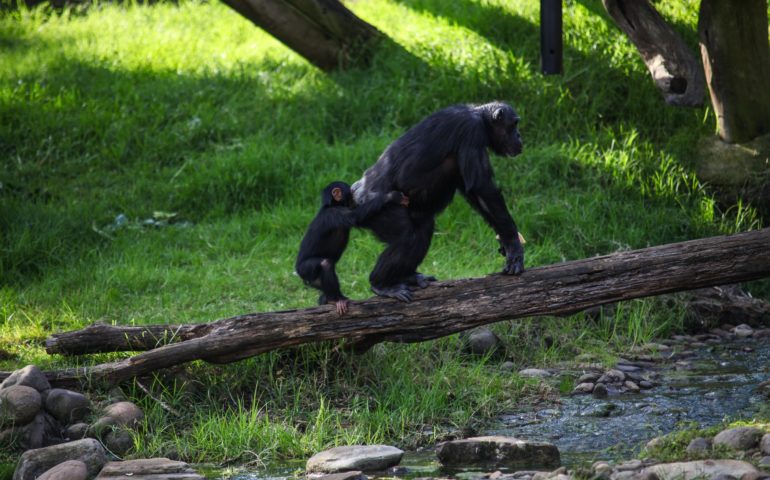Humans were thought to have the longest primate strides for their height, but now it turns out that chimpanzees take 25% longer strides than we do, thanks to their swiveling hips, which rotate by as much as 61deg every time they take a step to compensate for their crouched posture and shorter legs.
Compared with the strides of our closest primate relatives, even the tallest humans take relatively short steps. “Standardized by size, humans really don’t have long strides,” says Nathan Thompson from the New York Institute of Technology, U.S.. However, until recently, most scientists believed that the human stride was relatively long for efficiency; ‘this is taught in almost every introductory class and textbook,” Thompson says, explaining the misconception only became truly apparent when he began delving into the literature. And when Thompson began investigating how far chimpanzees rotate their pelvises as they walk, he began wondering whether swiveling their hips could hold the key to the chimpanzee’s longer strides. Intrigued by the possibility, he decided to compare chimps and humans walking over a range of different speeds and now he publishes his discovery in Journal of Experimental Biology that chimp strides are 25% longer than ours (for their height), thanks to their swiveling hips, which extend their strides 5.4 times more than the mini wiggles we perform when walking.
“Working with people and animals always has its difficulties,” says Thompson, who spent several years with Brigitte Demes, Susan Larson (both at Stony Brook University, U.S.) and Matthew O’Neill (Midwestern University, U.S.) familiarizing the chimpanzees with walking upright on two feet while they filmed the animals in 3D. Even working with the human walkers wasn’t without its challenges. Thompson remembers one volunteer who kept getting fits of the giggles because walking in bare feet on the treadmill felt weird; ‘they couldn’t help but walk in a totally bizarre way,” Thompson recalls.
Once Danielle Rubinstein, William Parrella-O’Donnell and Matt Brett reconstructed the human’s stride pattern and hip motions in 3D, the team scaled the humans down to the size of the chimpanzees and found that the although the humans’ legs were proportionally 112% longer, their strides were 26.7% shorter. Meanwhile, the chimpanzees swiveled their hips between 28 and 61deg in contrast to the humans, which barely twisted their pelvises at all, by only ~8deg. And when the team checked how much further the pelvic rotation got them in terms of stride length, the chimpanzees had a distinct advantage. Their swiveling hips extended their stride 5.4 times more, relative to their size, than the human’s diminutive swivel.
“I think that chimpanzees use pelvic rotations to try to squeeze every bit of stride length out, otherwise their strides would be—absolutely—very small,” says Thompson, explaining that apes and monkeys tend to walk on crouched legs that naturally shorten their stride; “I don’t think there are a lot of options other than rotating the pelvis, given their anatomical constraints,” he adds.
But why have humans ditched swiveling their hips when it could extend their strides further? Thompson suggests one possibility, that extreme rotations of the hips could throw out the natural swing of our arms and legs—which counterbalance each other—forcing our muscles to work harder and making walking less efficient; a price that simply might not be worth paying for an increased stride length. Thompson also explains that scientists had thought for decades that humans had evolved the longest possible stride for efficiency, but now that it turns out that our stride is considerably shorter than that of our nearest cousins, he suspects that other factors have had a larger impact on the way we walk. “Humans have had about 7 million years of selective pressure for economical bipedalism; this means that there has been a lot of time to experiment with the costs and benefits, so it might be worth it to walk with slightly shorter strides, because whatever energy we lose, we might make up elsewhere,” he suggests.
Chimpanzees shed light on origins of human walking
More information:
Nathan E. Thompson et al, The loss of the ‘pelvic step’ in human evolution, Journal of Experimental Biology (2021). DOI: 10.1242/jeb.240440
Provided by
The Company of Biologists
Citation:
Humans ditched swiveling hips for shorter stride than chimps (2021, August 20)
retrieved 20 August 2021
from https://phys.org/news/2021-08-humans-ditched-swiveling-hips-shorter.html
This document is subject to copyright. Apart from any fair dealing for the purpose of private study or research, no
part may be reproduced without the written permission. The content is provided for information purposes only.



